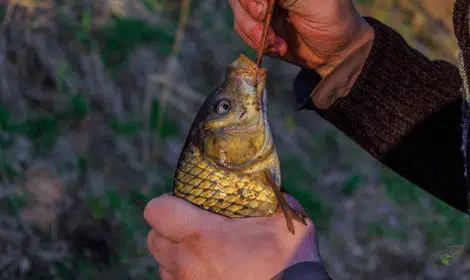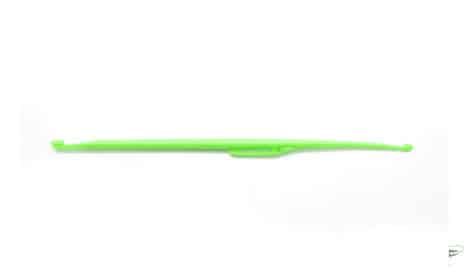
When it comes to unhooking fish with large mouths, such as carp, you can usually pop the hook out with your fingers or forceps if the hook is set a little further in the fish’s mouth.
Unfortunately, when it comes to fishing for other smaller coarse fish species such as gudgeon and roach (or other smaller fish), there is no way you will be able to get your fingers or forceps in the fish’s mouth if the hook is not in the lip of the fish.
This can prove a problem for beginners if they have no way of ejecting the hooking without hurting the fish.
In these circumstances, you should not pull on the hook or try to force forceps into their small delicate mouths.
Thankfully, a tool can be used to eject hooks from fish with small mouths easily if the hook is not easily removable from their lips.
In this post, I will focus on how to use a disgorger so you can safely and easily release any hooks stuck inside smaller fish.
How to Use a Disgorger?
Before I get into how to use a disgorger, I’ll give you a brief explanation of what a disgorger is.
A disgorger is a thin device usually made of plastic or aluminium that is used for releasing deep hooks from fish with small mouths or larger fish where the hook is still unreachable with your fingers or forceps.
A disgorger is a long slender tool with a cut and a notch at the end to run your line through and over the end of the shank of the hook.
Let’s get into how you can use a disgorger safely and effectively to release fish without causing any damage.
Using a disgorger for the first time can be a bit of a struggle and may seem like you need an extra hand, but there are a few tips you can use to make it slightly easier.
Hold the Fish
First of all, you want to hold the fish in one hand; I usually hold the fish in my left hand and use my prominent right hand for working the disgorger.
Remember to wet your hands before touching any fish, as you don’t want to remove their protective slime coating. This is just as important as using the disgorger safely as removing their slime coating onto dry hands can let infection and parasites into the fish.
You should be holding the fish with enough force that it can’t wriggle free but not too hard that you cause damage to their delicate fins and body.
If the fish is too large to hold in one hand, then you can leave the fish lying on your wet unhooking mat.
Place the Line In the Disgorger
Once you’ve got a hold of the fish or the fish is lying safely on a wet unhooking mat. Slide the line through the slot at the end of the disgorger close to the mouth of the fish.
Twist the disgorger to wrap the line around the disgorger, so the line doesn’t come out of the slot when you slide the disgorger down the line towards the hook.
Keeping the line tight while holding the fish in one hand in the disgorger is the most challenging part of using a disgorger.
One way to overcome this is to place the rod somewhere suitable that you can put very slight tension in the line by moving the fish away from the rod tip to take up any slack line.
Do not pull the fish hard, and make sure there is only very slight tension in the line.
Remove the Hook
Once the line is straight, and your disgorger is wrapped around the line and fixed, the next step is easy.
Slide the disgorger down into the fish’s mouth and towards the hook’s shank.
Once the hook has slid into the slot on the bottom of the disgorger, push down gently until the hook is released and then slowly pull the hook and disgorger back up out of the fish’s mouth, taking care not to rehook the fish.
Job done.
Release the Fish
The next step is to release the fish. No matter what species of fish you’re targeting it is essential to minimize the time the fish is out of the water.
Hold the fish upright in the water, slowly cradling it from below.
When the fish has recovered, you will feel it try to kick and swim from your hands.
When this happens, let go of the fish and let it swim away.
Disgorger Video
If you prefer to follow along with a video, then the video below does an excellent job at showing the steps to using a disgorger.

How to Avoid Deep Hook Fish?
Although disgorgers are a great tool for releasing the few unfortunate fish that get deep hooked, there should be steps to avoid these types of hooking.
Ideally, you want the hook to be set in the mouth of the fish where you can easily release it with your fingers or forceps, limiting the damage caused.
Deep hooking is usually the result of not setting the hook quickly enough when your bite indication method registers a bit.
For float fishing, this can be when the float drops; if you’re using a quiver tip rod, this will be when the rod tip bends, of if you’re using bite alarms when your alarm sounds.
You should never leave your rod unattended and keep your eyes on your float or quiver tip for any bites.
That’s All
Using a disgorger is simple when you know the simple steps you’ll need to take. They are an extremely effective for releasing deep hook fish without causing any damage with larger forceps.
Care should be taken to avoid deep hookings but sometimes they are unavoidable. Disgorgers should be your go-to in these situations.
If you have any questions, don’t hesitate to leave a comment below, and I’ll get back to you ASAP.



